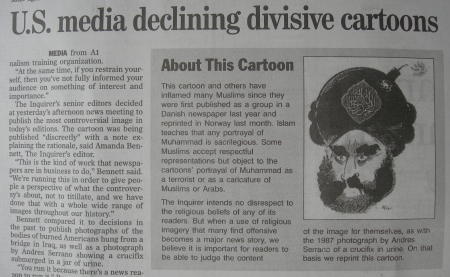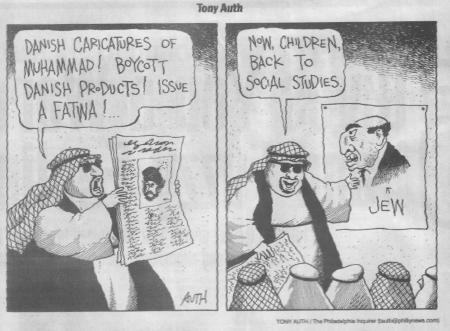





|
|
|
|
February 07, 2006
Cartoons your newspaper (except the Inquirer!) won't let you see!
Via Pajamas Media and Michelle Malkin, I see that the Philadelphia Inquirer has received praise from the New York Times for daring to publish one of the forbidden Danish cartoons. Here's how it appears in the Inquirer's hard copy:  In a post which has drawn comments from all over the world, I had originally chided the Inquirer for not publishing the cartoon, and said I'd apologize for my post's title -- ("Cartoons your newspaper won't let you see") if they did. Much to my surprise, the Inquirer first linked to the cartoons, then ran the hard copy above, which I scanned and put into the post. Despite the fact that the post continues to draw comments, it's no longer on the front page of the blog, hence the need for a new post. With a new title! (As Michelle notes, the Inquirer is joined by the New York Sun, the and the Riverside Press Enterprise.) It was very brave of the Inquirer to do this and I agree with Michelle: The point that needs to be hammered again and again is that the newspaper did not publish the cartoon to deliberately offend Muslims or to make an anti-Islamist statement, but to inform. Which is what newspapers, may I remind them, are supposed to do....The Inquirer explains the editorial decision: To us, this was a moment for newspaper journalists to do what they are uniquely qualified to do in this country - to lay out all sides of the issue for a well-informed public to debate and discuss. The Inquirer published the image to inform our readers, not to inflame them. Before we published it, we interviewed a wide range of people, from Muslim theologians to experts in journalistic ethics. We considered the publication of the image in the same way we have previously considered publishing difficult or troubling images. Other such examples include the burned bodies of contractors hanging from a bridge in Fallujah, and artistic works that included disturbing Christian imagery.Good work! I feel truly blessed to have such a good, principled, newspaper. And remember, this is coming from someone who disagrees with the Inquirer all the time (as any regular reader will confirm). UPDATE: My apologies for not including the Rocky Mountain News on the list of exceptions! (I hope I can keep on apologizing....) MORE: Editor and Publisher has more on the Inquirer protest. Accoring to the NYT, the protesters are demanding an apology by this Friday. (Why Friday, I can't imagine...) I can't help notice this comment from CAIR's Ibrahim Hooper: Ibrahim Hooper, a spokesman for the Council on American-Islamic Relations in Washington, said that despite The Inquirer's decision, he had seen restraint on all sides of the issue within the United States. "I think The Inquirer's move was the exception that proves the rule," Mr. Hooper said.I didn't know the United States had such a "rule." (Remember, that's coming from a guy whose organization wants to sandblast a sculpture from the wall of the Supreme Court.) MORE: Obviously, I hope the Inquirer does not apologize. UPDATE: Via InstaPundit, NRO's Jim Geraghty also praises the Inquirer: I’m a fan of the Philadelphia Inquirer, and not just because they sometimes run my column or quote this blog. They’re proving they’ve got guts (or some other part of the anatomy associated with courage and fortitude), as the first major paper to publish the infamous cartoons.If only the praise from the New York Times had sounded more like that! (But I'm trying not to be percieved as insulting the New York Times...)
Too bad Keller, Calame and others at the Times lack the moral and journalistic courage of Amanda Bennett, editor of the Philadelphia Inquirer, and her publication which ran one of the cartoons on Saturday.I hope they do! MORE: In a comment below, Callimachus asked whether there was a "small version of the bomb-head caricature [] in a Tony Auth cartoon on their editorial page a few days ago." Yes, there was! And it was so good I had to pull it from the recycling bin and scan it. Here it is:  MORE: The Inquirer's editorial page editor Chris Satullo interviews Tony Auth about the cartoons: Satullo: How do you deal with upset people who say you use stereotypes and depict their religion or ethnicity as all uniformly terrorist, and they feel you are painting with a too-wide brush? What is your response? Regarding the role of political cartoons generally, I enjoy this quote from "Boss" Tweed: In perhaps the best known example of the force of the political cartoon, Thomas Nast’s images in Harper’s Weekly played an important role in the overthrow of the Tweed Ring in 1870s New York City. An exasperated Boss Tweed is recorded to have demanded of his henchmen, “Stop them damn pictures. I don’t care so much what the papers write about me. My constituents can’t read. But, damn it, they can see pictures.”Perhaps they're afraid the message will resonate. posted by Eric on 02.07.06 at 04:38 PM
Comments
Yep, good job to the Inky (with whom I, too, almost always disagree editorially nowadays). I wonder if Trudy Rubin thinks it was a good idea? And good on you for noticing it big and clear. Was I dreaming this, or did a small version of the bomb-head caricature also turn up in a Tony Auth cartoon on their editorial page a few days ago? Callimachus · February 9, 2006 04:46 PM |
|
March 2007
WORLD-WIDE CALENDAR
Search the Site
E-mail
Classics To Go
Archives
March 2007
February 2007 January 2007 December 2006 November 2006 October 2006 September 2006 August 2006 July 2006 June 2006 May 2006 April 2006 March 2006 February 2006 January 2006 December 2005 November 2005 October 2005 September 2005 August 2005 July 2005 June 2005 May 2005 April 2005 March 2005 February 2005 January 2005 December 2004 November 2004 October 2004 September 2004 August 2004 July 2004 June 2004 May 2004 April 2004 March 2004 February 2004 January 2004 December 2003 November 2003 October 2003 September 2003 August 2003 July 2003 June 2003 May 2003 May 2002 See more archives here Old (Blogspot) archives
Recent Entries
• War For Profit
• How trying to prevent genocide becomes genocide • I Have Not Yet Begun To Fight • Wind Boom • Isaiah Washington, victim • Hippie Shirts • A cunning exercise in liberation linguistics? • Sometimes unprincipled demagogues are better than principled activists • PETA agrees -- with me! • The high pitched squeal of small carbon footprints
Links
Site Credits
|
|
Thank the Philly Inquirer for me too, willya? Also, if they really want to be balanced and informative, they should print this stuff alongside some samples of Jew-bashing cartoons taken from Arab publications.
You think our MSM is bad? Check this out:
http://muttawa.blogspot.com/2005/11/saudi-arabia-to-tackle-racism.html